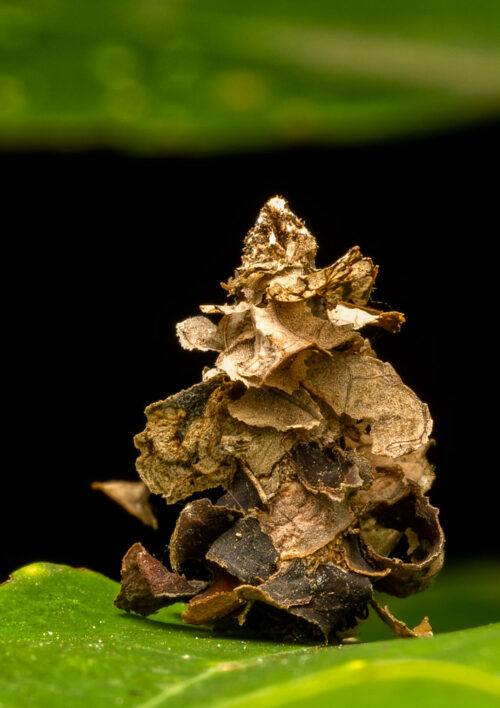
As soon as the caterpillar of the bagworm moth or case moth (Psychidae) of the family of moths hatches, it weaves a silk cocoon around itself, inside which it will live until it grows into an adult moth. To make its life as a larva safe and protected from predators, the caterpillar reinforces its silk cocoon with pieces of twigs, leaves and other plant matter. Each species chooses different materials to make its cocoon.
Here are the one’s which specialized in using the dried leaf as their hideout. It was found in Sitaphal or the sugar-apple tree (Annona squamosa). The sugar apple is the fruit of Annona squamosa, a native of tropical climate in the Americas and West Indies which Spanish traders brought to Asia.

The cases of bagworm moths are attached to rocks, trees or leaves, but they do not stay rooted to the same spot. The caterpillar remains mobile as it hunts for food, and it carries the protective case along with it wherever it goes. They move somewhat like turtles, pushing their heads out of the opening at the top to advance forward and then drag the case behind. The case has another, smaller opening at the bottom. The caterpillar comes out from the top to feed and ejects the waste from the bottom end. The bottom opening is also the exit hatch for the emerging adult. If the caterpillar feels threatened it can seal off the end of the cocoon, cutting a new opening once the threat has passed.
As the bagworm grows, it expands its case by adding more twigs to the top. They poke their head out of the top of their case, collect additional twig, cuts them off to appropriate size and attaches them temporarily to the top of the case. They then disappear inside to cut a slit where they plan to attach the new stick.

The cases of the bagworm moth are incredibly tough and very difficult to break open. And since the cases are composed of materials from their habitat, they are naturally camouflaged from predators such as birds and other insects. The attachment substance used to affix the case to host plant, or structure, is also very strong, and in some case require a great deal of force to remove given the relative size and weight of the actual structure itself.
Bagworm cases range in size from less than 1 cm to 15 cm among some tropical species. Each species makes a distinctive looking case. The cases of the more primitive species are flat, while specialized species exhibit a greater variety of case size, shape, and composition.

Bagworm moths spend most of their lives in the caterpillar phase, and hence inside the case. The females continue to live in their cases after they’ve pupated into adult moths, but the males leave their cases after pupation to fly off in search of females to mate with. After they mate, the females lay their fertilized eggs in their old bags. Once the larvae hatch, they will create their own tiny log house.
You can check my other article on bagworm at https://drkrishi.co.in/bagworm-moth/ or go to my good friend Karthik’s Journal – https://www.wildwanderer.com/bagworm/.

